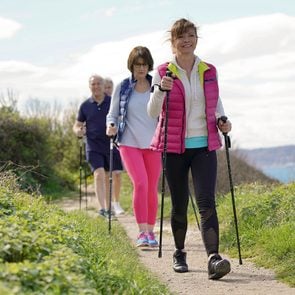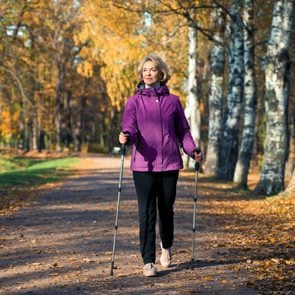Not long ago, Linda Khan was sitting by a hospital bed in Houston, feeling ill at ease. Beside her lay her 88-year-old father. His heart was faltering. He needed surgery.
What troubled her almost as much as his health was the fact that all day the two of them had engaged in nothing but depressing small talk. She and her father had always had good conversations, but now he seemed to be sunk in querulous contemplation of his predicament. He talked about the lousy hospital food, the tests, the doctors, the diagnosis, the potential outcomes. The scope of his interests seemed to have shrunk to the size of the room.
That day in the hospital, Khan’s eye fell on a stack of books that people had brought as gifts. Her father had always been a reader, but lately he didn’t have the energy or ability to focus. She picked up Young Titan, Michael Shelden’s biography of Winston Churchill, and started to read it out loud.

The Benefits of Reading Out Loud
“Right away, it changed the mood and atmosphere,” she says. That afternoon, Khan read to her father for an hour. It was a relief and a pleasure for both of them, and boosted their senses of well-being. Reading gave Khan a way to connect with her father and help him in a situation that was otherwise out of her hands. Listening allowed her father to travel on the sound of his daughter’s voice, back into the realm of intellectual engagement, where he felt like himself again.
“He’s in and out of the hospital a lot now,” Khan says, “and I always read to him.”
That may be just what the doctor ordered. In a 2010 study in the United Kingdom, adults who joined weekly read-aloud groups reported better concentration, less agitation and an improved ability to socialize. The survey’s authors attributed these improvements in part to the “rich, varied, non-prescriptive diet of serious literature” that group members consumed, with fiction encouraging feelings of relaxation and calm, poetry fostering focused concentration, and narratives of all sorts giving rise to thoughts, feelings and memories.
The second-century Greek doctor Antyllus even prescribed daily recitation to his patients, recommending it as a kind of health-giving tonic and insisting that epic verse is good for one’s health.
An epic poem might be a tall order, but in truth, almost any kind of reading out loud to others can be beneficial. A 2007 study of community reading groups in the U.K. found that groups had both social and therapeutic benefits for participants. The study’s authors wrote: “Reading a literary text together not only harnesses the power of reading as a cognitive process; it acts as a powerful socially coalescing presence, allowing readers a sense of subjective and shared experience at the same time.”

Reading Aloud to Pets
We are not the only species that benefits from this kind of oral medicine. Dogs do, too, which is why, since 2014, volunteers at the American Society for the Prevention of Cruelty to Animals have read to the animals under the group’s care.
“Ten or 15 years ago, I was essentially the only person who worked with the neglect and abuse cases,” says Victoria Wells, the organization’s senior manager for behaviour and training. “I used to sit with them, in front of their kennels, and play guitar and sing. I noticed that the dogs who were very fearful, shivering and cowering in the back of their kennels, would slowly creep forward.” Dogs demonstrated less anxiety.
The dogs’ response to music led to the idea of reading out loud. It was a practical means of allowing a larger number of volunteers to minister to recovering animals. Some volunteers keep the animals apprised of current events by reading the newspaper, some choose children’s books, and others prefer adult fiction. On the day I stopped by, a retired opera singer was reading the sci-fi thriller Logan’s Run to half a dozen dogs.
“The fact that it’s not threatening but is attention all the same is what’s most beneficial,” says Wells. “I think it’s that soothing, even tone of voice and the presence of somebody to keep them company that benefits them.”
The Benefits of Reading Out Loud Work Both Ways
Readers get rewards, too. For Neil Bush, the late-life hospitalizations of his famous parents, George H.W. and Barbara Bush, became opportunities to repay a debt of gratitude. “When I was a kid, [my mother] would read to me and my siblings,” he told a reporter in the spring of 2018, shortly before his parents’ deaths. With his mother and father in and out of care, he said, “We’ve been reading books about Dad’s foreign policy and, most recently, Mom’s memoir.”
Reading to a spouse, sibling or parent might seem a little peculiar. Right before Linda Khan started to read to her father, she was tempted to put the book down. It felt odd to presume to read to a man who, for her entire life, had always been strong and independent. She didn’t want him to feel patronized. Her fear was misplaced; they both ended up loving the experience. Like so many others who brave the momentary weirdness of reading to another adult, they were, to borrow a phrase from Wordsworth, surprised by the joy of it.
Who wouldn’t want that? One night years ago, a friend of mine wandered into his family’s living room after supper and picked up a copy of Michael Shaara’s Civil War novel The Killer Angels. Without thinking much about it, he started to read the preface out loud. Immediately, he was joined by his eldest son, who was about 12 at the time. A moment later, his wife came in, followed by the couple’s two young daughters, who at six and eight were not perhaps the target audience for an introduction to Robert E. Lee and Joshua Chamberlain but wanted to be part of a family moment. Within a few minutes, everyone seemed so comfy and engaged that my friend kept reading. It went on for an hour. He picked up the book again after dinner the next night, and the next, until he had finished it.
Excerpted from the book The Enchanted Hour by Meghan Cox Gurdon, Copyright © 2019 by Meghan Cox Gurdon. Reprinted with permission of HarperCollins Publishers.
Now that you know the benefits of reading out loud, find out why you should always read before bed.
Canadians take butter tarts really seriously. While the recipe for a basic butter tart is relatively simple, people are rightfully proud of their perfect (and unique) recipes. There are competitions that challenge bakers to find the most innovative fillings beyond the standard pecan, walnut and raisin options. Past winning creations at Ontario’s Best Butter Tart Festival in Midland include a sweet potato ginger strudel tart and a passionfruit mango variation. Bitter rivalries are formed over the title of best butter tart in a region. There’s even a whole festival circuit that has bakers schlepping their gooey tarts to agricultural fairs all around the country.

There’s More Than One Butter Tart Trail
Want to make a day (or even a weekend) out of the dessert? Ontarians are spoiled for choice in the butter tart trail stakes: There are two self-guided road trips that will deliver you to some of the best butter tarts in the country. Both located a short drive from Toronto, the Wellington County Butter Tart Trail and the Kawarthas Northumberland Butter Tart Tour are must-visits for a city-getaway that’s filled with delicious eats.
Wellington County Butter Tart Trail
The Wellington County Butter Tart Trail started first, in 2006, as a way to boost local tourism and shine a spotlight on the food scene, according to Christina Mann, the Taste Real Coordinator for the County of Wellington, which organizes the trail. Trail trekkers can drive all (or just some) of the 80-kilometre length of the trail from North Wellington down to Guelph. The trail boasts 17 stops, and takes drivers past other attractions, such as the horse-and-buggy communities in the northern part of the county. You’ll visit bakeries, grocery stores, gas stations and other less conventional butter tart stops. “Wherever you go, they will say that their butter tarts are the best,” says Mann. “But we offer not just butter tarts but a whole farm and food experience.”
Kawarthas Northumberland Butter Tart Tour
The Kawarthas Northumberland Butter Tart Tour came later, in 2011. (After a brief butter tart war, during which Wellington County sent a cease-and-desist letter to their competition in the Kawarthas, the two operations called a truce in 2013 and now co-exist peacefully.) The Kawarthas’ tour, which is located further east in Ontario, has over 50 stops and only features bakeries. The tour isn’t just about the butter tarts (though, let’s be real, it’s mainly about the sweet treat), but also the road trip experience itself. “A lot of people associate the tarts with their family,” says Diane Rogers, the owner of DooDoo’s Bakery and Cafe, a business that’s a part of the Kawarthas’ tour. “Going on the tour and having a butter tart kind of transports people back to their childhood. It’s a way to show your love for your family, through butter tarts.”
Check out 10 great day trips from Toronto on a single tank of gas.
What’s it Like on the Tour
This summer, I had the chance to visit Wellington County’s butter tart trail and sample butter tarts throughout the region. On a rainy Saturday, I drove from downtown Toronto up to North Wellington and the various Mennonite communities in the region. My plan was to start there and work my way south towards Guelph, hitting up as many stops as I could in a day.
Misty Meadows Market
My first stop of the day was Misty Meadows Market in the hamlet of Conn, Ontario. The quaint grocery store is operated by the local Mennonite community and sells fresh baked goods, including tarts, of course, but also amazing date oatmeal cookies, fresh bread and local produce. It was only noon, but Misty Meadows was already busy. I was dismayed to discover they were already sold out of my preferred pecan butter tarts. The store also offers both plain and raisin tarts, but the latter were the only ones left—and this always controversial filling was a definite no-go for me. My tip: Misty Meadows opens at 8 a.m. and it’s best to arrive early. The store is also closed on Sundays, and I’d recommend going on a weekday, not on a Saturday, like me.

Fergies Fine Foods
From Conn, I drove south to Fergies Fine Foods in Fergus, which sells pre-made frozen meals, a variety of sweet and savoury baked goods and possibly the best sausage roll I’ve ever had. Though I was here for the butter tarts, owner Miriam Foell nearly tempted me with a delicious-looking brownie—as it turns out, there’s also a brownies tour for local dessert enthusiasts and of course her shop is an essential destination. Reluctantly, I told her I was there for the butter tarts (and, yes, also a sausage roll, a curry chicken pie and a couple of locally produced apple ciders…). Fergies sells the classic pecan and raisin options, as well as a mouthwatering bacon maple flavour, which was sadly sold out. I decided to go with their specialty: a delicious bourbon pecan butter tart, which I devoured in my car. The tart was heavenly, with the rich flavour of the bourbon mellowing out the overall sweetness of the treat. My tip: come on an empty stomach—it’s not just the butter tarts at Fergies you’ll want to try.
Check out more must-try Canadian foods—and the best places to find them.
Belwood Country Market
From Fergus, I continued south to Belwood Country Market, right on the shores of Lake Belwood. This stop had a little bit of everything: a deli section, gas station snacks, fish bait and, of course, butter tarts. The market also offered a smorgasbord of flavoured tarts, including Reese’s peanut butter cup, blueberry white chocolate and raspberry coconut. After much internal debate, I chose a Skor tart. I took my treat outside, sat on a picnic table right by the water’s edge, and bit in, relishing in the sugary warmth of the fresh tart. Unsurprisingly, the butter toffee Skor went perfectly with the flaky pastry. My tip: come with friends and split the tarts so you can sample all the unique flavours on offer.
With the Grain
Finally, I drove south to Guelph to visit With the Grain, a picturesque bakery that is no-nonsense when it comes to butter tarts: here, only the traditional plain, pecan and raisin fillings are available. Aside from the butter tarts, With the Grain also makes fresh bread, cookies and a rotation of cupcakes. When asked about their adherence to the classic tart recipes, Erin Wright, the owner, responds, “Why mess with perfection?” It’s hard to argue with that, especially when their pecan butter tart was just the perfect, gooey sweet treat that I needed to end my day. My tip: grab one of With the Grain’s unique loaves of bread (the cheddar garlic sourdough was really calling my name) to help soak up all that sugar.

A Perfect Day
Sugar crash aside, the adventure I had on this butter tart trail was one of the highlights of my summer. I plan to go back and visit some of the stops that I didn’t get the chance to (note to self: leave earlier to beat the other butter tart trail followers). Plus, you can make the trip out more than once and chart a different path every time. Next time, I might try going east to west, to hit some of the more far-out stops I missed on my north to south route.
From my car, I was able to see a part of the province I rarely visit. On the drive home, with the road stretched out before me, I was reminded of my summers as a kid, sitting under a tree and licking the sticky filling off my fingers. “It just brings people joy,” says Rogers. “For a lot of people who can’t afford a big vacation, it’s a way to take a weekend away and do some day tripping and make new memories.”
If you enjoyed discovering Ontario’s butter tart trail, brush up on the butter tart’s fascinating origins.
Diabetes, especially Type 2, is more than just a rising global statistic with an estimated one in 20 Canadians currently pre-diabetic. This disease affects an individual’s quality of life, leading to potential complications such as cardiovascular disease, nerve damage, kidney disease, eye issues, and psychological effects, like depression.
Diabetes can create a drain on the patient, but it also significantly affects healthcare systems through direct medical costs and the indirect costs of managing diabetes-related complications. Thus, much of the healthcare community agrees that the fight against diabetes is an important issue that requires urgent attention and innovative strategies.
Fortunately, if you’ve been intending to step up your health game, data from a hopeful new study might be all you need to get moving. According to June 2023 findings published in the British Journal of Sports Medicine, two particularly upbeat activities could drastically lower your risk of developing diabetes if you make a little time to move to them every day.
For more wellness updates, sign up for the (free!) Reader’s Digest Health Report.
Findings from the study
The research found a strong link between higher levels of physical activity—specifically moderate-to-vigorous-intensity physical activity like dancing or brisk walking—and a reduced chance of developing Type 2 diabetes.
The researchers discovered a direct correlation between the amount of moderate-to-vigorous activity performed and the likelihood of developing Type 2 diabetes, even when considering genetic predispositions. To put it simply, the more a person engaged in this type of activity, the lower their risk of developing the disease…even when it ran in their family.
The research team compared groups of participants based on their activity levels and found that those who were more active had a significantly lower risk, or hazard ratio, of developing diabetes. A hazard ratio, to clarify, is a tool researchers use to compare the likelihood of a certain event (in this case, developing diabetes) happening in one group versus another.
The study grouped participants by the activity amount performed daily. One group engaged in activity for 5.3 to 25.9 minutes, another for 26.0 to 68.4 minutes, and a third group for more than 68.4 minutes. The researchers found hazard ratios of 0.63, 0.41, and a remarkably low 0.26, respectively—meaning those who did the most moderate to vigorous physical activity showed the lowest risk.
To put this in perspective, doing more than 68.4 minutes of moderate to vigorous physical activity per day was associated with a striking 74% lower risk of developing Type 2 diabetes when compared to those who did less than 5.2 minutes per day.
The study’s senior author, Professor Melody Ding from Sydney University, addressed the issue of genetic risk, which is beyond individual control: “People are unable to control their genetic risk and family history,” Dr. Ding said. “But this finding provides promising and positive news that through an active lifestyle, one can fight off much of the excessive risk for Type 2 diabetes.”
Find out what can happen to your body when you start walking 10,000 steps a day.
The takeaway
This study suggests the path to a healthier life appears to be as simple as shaking a leg. As forms of moderate-to-vigorous physical activity, walking and dancing are not only fun but also highly beneficial to health. Dancing can serve as a total-body workout, engaging various muscle groups and improving cardiovascular health, flexibility, and balance.
On the other hand, brisk walking is a low-impact activity that boosts heart health, has been clinically shown to lift the mood, and can be easily incorporated into daily routines, among other advantages. Both activities can help manage body weight, improve insulin sensitivity, and enhance overall metabolic health, reducing the risk of developing Type 2 diabetes.
The battle against diabetes might not require grandiose interventions but rather small, enjoyable lifestyle changes. Taking up dancing or incorporating brisk walks into your daily routine could significantly lower your risk of developing Type 2 diabetes.
Remember, it’s not merely about knowing these health benefits but integrating them into your life. After all, in the face of alarming health statistics, making informed and conscious choices about our lifestyle habits is more critical than ever.
Check out more expert advice on how to prevent diabetes.

What is Nordic walking?
Nordic walking turns a standard walk into a full-body workout by incorporating specialized walking poles. Developed in Finland as an off-season activity for cross-country ski athletes, it’s now one of Canada’s fastest growing activities.
According to Mandy Shintani, a Vancouver-based occupational therapist and gerontologist, Nordic walking’s popularity has surged since the pandemic kicked off. At a time when gyms were off-limits, she says Nordic walking presented a fantastic opportunity to get exercise and socialize outdoors. “Every year there’s been increasing interest, but in [2020-2021] we saw the biggest jump with a 25 percent increase in pole sales and interest in courses,” Shintani says.

Health benefits of Nordic walking
When using the specialized poles (one for each hand), your upper body is performing an action similar to cross country skiing, one of the best activities for cardiovascular fitness. In addition to getting your blood pumping, it’s engaging 70-90 percent of your muscles (including the abdomen) in a core-strengthening, full-body workout. Studies show Nordic walking burns an average of 20 percent more calories than regular walking (with some subjects burning as much as 46 percent more calories).
It’s also appealing from an accessibility standpoint: Nordic walking poles provide stability for those who suffer from hip and knee osteoarthritis, and any condition affecting balance such as Parkinson’s disease. Simply having those two extra points of contact with the ground reduces the risk for falls, and makes Nordic walking an attractive option for those concerned about maintaining mobility and independence. Some even find Nordic walking poles a more effective rehabilitation option than using a walker or cane.
But the health benefits of Nordic walking extend beyond the physical. Compared to your typical stroll, Nordic walking can have a positive impact on your sense of well-being.
“It turns walking into power walking, and because you’re getting a greater cardio workout, you’re producing more endorphins, which leads to better moods. I know of some mental health units that have used it as a way to treat depression,” says Shintani.
And you can’t ignore the convenience factor. With a set of walking poles, any location transforms into a gym; plus, being in the great outdoors provides its own health benefits.

A beginner’s guide to Nordic walking
Just as you wouldn’t use a tennis racket for squash, you can’t use conventional ski poles for Nordic walking. Nordic walking poles are designed differently than their skiing (and even hiking) counterparts, and can be found in drug stores, sporting good shops and online.
Whereas hiking poles are held straight up and down with bent elbows, Nordic walking poles ought to be used on a diagonal angle, with a straight elbow. Because there is a technique to it, it’s best to check in with your local community centre as many hold introductory classes and weekly walking groups to help you get started.
“It’s not much different from other sports in that if you can get proper instruction, you’ll reap more of the health benefits. The more you do the technique correctly, you’ll get a better a workout,” notes Shintani.
If you’d like to give it a go for rehabilitation purposes, professionals including occupational therapists, physiotherapists and kinesiologists ought to be able to provide guidance. (In some provinces rehab will require a doctor’s referral, so you may need to start this process with a visit to your general practitioner.)
As keen as you may be to get going, take care not to overdo it. One of the most common mistakes people make when Nordic walking is to exceed their walking tolerance. Since Nordic walking engages the entire body, it’s quite likely you’ll be using muscles that don’t get a regular workout. Take the time you need to acclimatize or you’ll put yourself at risk for injury.
“It’s an activity that’s hard to understand until you try it yourself. Not until people get the poles in their hands do they get it, but you’ll get to a point where just love using them,” Shintani says.
Now that you know what Nordic walking is, find out what happens when you start walking 10,000 steps a day.
Road trips! We love them. We’ve always loved them. Sometimes the road trip is a day trip, sometimes a multi-week trip and sometimes it’s a ride on a bus where we both enjoy staring out the window.
For much of my working career, I was able to extend my vacation allotment with banked overtime. My husband, John, a self-employed cabinet maker, matched his vacation time to mine. Some years we travelled from Toronto only as far west as Banff. Other years, the extra weeks of vacation time took us to Vancouver Island, where we spent as many days as we could in Pacific Rim National Park Reserve before heading back home. For flatlanders by birth, the Rocky Mountains and the natural beauty of the old-growth forests were a huge draw. It’s no surprise that we eventually retired to the West Coast.

Setting Our Own Pace
We currently live on Vancouver Island, surrounded by the ocean and an abundance of tall trees. As appealing as that was so many years ago, we find ourselves now yearning for the open plains and Prairies. On our vacations from work, we never felt that we had the time to stop and smell the proverbial roses. Now, the distances we travel are no longer so great and we stop to read the historical markers and visit attractions along the way. We stay at municipal campgrounds that are always so well-cared for and near to the town centres. During the day, we ride our bicycles to see and photograph the uniqueness of each city or town. Our focus for the last several years has been to explore the places we somewhat neglected in our single-mindedness to reach Banff and the coast. Places in British Columbia like Field, a town that was set up for the railway workers, and is not only a busy train route, but also boasts beautiful scenery and heritage buildings.
Discover more hidden gems in B.C.

Exploring Alberta
Alberta is so much more than Banff and ranch land. Little Bow Provincial Park is a wonderful spot to get out on bikes and view the Prairie landscape and expressive skies. Granum’s town buildings, residential streets and back lanes provide abundant photo ops.
A bike ride into Milk River offers a respite in the community garden that came to be because of the efforts of a few people who gained permission to use a vacant lot.
Check out more great bike trails across Canada.

One of the most unusual stops we made in Alberta was at the Torrington Gopher Hole Museum. The dioramas containing stuffed Richardson’s ground squirrels were a bit off-putting at first but we soon forgot our initial discomfort and enjoyed the humour. Sometimes, chance sent us to places we wouldn’t have thought of visiting—like Bassano, Alberta, the best town by a dam site. My sister unknowingly instigated that trip 40 years ahead of time. She gave us a souvenir tray that she’d bought at a garage sale simply because the photo on the tray included a VW Beetle that was parked at the dam.
Here are 10 unusual museums worth visiting.

Striking Prairie Landscapes
A photographer at a Banff farmers’ market prompted our visit to Flaxcombe, Saskatchewan, sharing the location of the grain elevator photo we were admiring. Photographing these disappearing silent sentinels is a favourite subject of mine.
Don’t miss this gorgeous gallery of grain elevator photography.

In Inglis, Manitoba, the heritage society is working to preserve five grain elevators that have been designated as National Historic sites. There are so many communities across this land where residents are working hard to preserve the history of the area. It is inspiring.

At night, the haunting whistle of the frequent freight trains wake us from a deep sleep. The screeching, squealing and rattling of railcars as they travel across the vast landscape might annoy some weary travellers but to us it is a comforting sound that is reminiscent of our youth. There is something engaging, perhaps even romantic, about the continuous travel of people and freight trains moving across this country.

There is true beauty and uniqueness in Canada. We’ve experienced that firsthand in every province and territory we’ve visited. We are hopeful that we will not only travel across to Newfoundland and Labrador again, but also be fortunate enough to visit Nunavut for the first time someday—in the meantime, the Prairies are calling.
Check out more fantastic photos of the Canadian prairies that’ll have you packing your bags.

Calgary summers are famous for many things—the sunshine, the Stampede, the Beltline nightlife—but the most memorable might be the baseball-sized chunks of ice plummeting from the sky. Here in “Hailstorm Alley,” the moniker given to the stretch between Red Deer and Calgary, Canada’s two worst hailstorms have shattered windows, downed power lines and wreaked billions of dollars in havoc.
A record-breaking Calgary hailstorm
The most destructive hailstorm in Calgary history—and the fourth costliest natural disaster in Canada—took place on June 13, 2020, when a balmy summer day turned into a wintry hellscape soon after thunder roared around 6:40 p.m. By 7:00 p.m., hail began pelting the airport at the northeast corner of the city. Temperatures dropped more than five degrees Celsius in six minutes. Falling at speeds of up to 100 kilometres per hour, three-inch hailstones punched holes in lawns and roofs, shredding siding and crushing crops.
Just to give you a perspective of the size #abstorm pic.twitter.com/CnccwgCTdY
— Adnankhan159 (@Aishfaq159hotm1) June 14, 2020
Overland flooding was so sudden, drivers had to be rescued from their cars on Deerfoot Trail highway. By the time the storm ended several hours later, it left $1.3 billion in insured damages, with more than 70,000 claims on homes and vehicles in the city’s densely populated northeast.
The 2020 hailstorm beat the record set by another catastrophic Calgary hailstorm on September 7, 1991, which caused damage totalling an estimated $880 million in today’s dollars. In just 30 minutes, golf ball-sized hail smashed windows and crushed birds, while flash flooding built up so much pressure in city sewers that it blew the covers off 15 manholes. A four-acre greenhouse in the city’s northeast was shattered into a “sea of glass” that fell onto thousands of delicate nursery plants.
In addition to those two whoppers, separate Calgary hailstorms in 2010 and 2014 caused more than $400 million in damages each.

Why are there so many hailstorms in Calgary?
Although those storms are noteworthy in scale, hail falls in Calgary an average of five times every year. It’s not just a matter of bad luck: in the lee of the Rocky Mountains, the city happens to sit at the confluence of some unique wind and weather patterns that are especially conducive to hailstorms.
As high-elevation winds sweep in from the mountains to the west, they can combine with cold winds from the north and warmer, humid air from the south to create a swirling, volatile weather system called an upper trough, a ripe breeding ground for storms. Hail happens when violent updrafts inside tall cumulonimbus clouds bounce falling raindrops back up into the upper atmosphere, where colder temperatures turn them to ice. The popcorn-like rising and falling can add layer upon layer of ice, creating larger hailstones that finally get heavy enough to fall to earth. Hail that reaches the diameter of a quarter (about 2.5 centimetres) or more becomes destructive, potentially cracking windshields and injuring people.

Calgary’s long-term forecast
To try to mitigate the chaos and expense caused by hail, a group of insurance companies began investing in the Alberta Hail Suppression Project in the late 1990s. Using a technique called cloud seeding, specially equipped planes spray storm clouds with silver iodide smoke particles, which encourage the development of ice crystals. In theory, the more crystals, the more they compete for available water within the clouds, which creates smaller ice pellets and inhibits the formation of larger, bullet-like hailstones. To date, cloud seeding hasn’t been shown to prevent Calgary’s more destructive hailstorms.
Meteorologists say Calgary can expect to see more hail damage in the future, as global warming increases the risk of all types of severe weather, while the city’s population grows and the cost of building repairs rises. If you find yourself caught in a hailstorm, the City of Calgary recommends leaving open areas and seeking shelter immediately, staying away from windows, doors and skylights.
Next, read the terrifying story of the worst tornado in Canada’s history.
Recent research highlights that the timing of our meals, particularly the last meal of the day, can significantly affect our health. The story is not merely about what we consume, but also about when we do so. The debate about dinner timing finds substantial scientific backing with a Brigham and Women’s Hospital (BWH) study published in Cell Metabolism in October 2022, suggesting that early dinners could have more health benefits than previously believed.
For more wellness updates, sign up for the (free!) Reader’s Digest Health Report.
The science of early dinners
Senior author of the study, Frank A. J. L. Scheer, PhD, Director of the Medical Chronobiology Program in BWH’s Division of Sleep and Circadian Disorders, explained the study’s objective in a press release: “We wanted to test the mechanisms that may explain why late eating increases obesity risk.”
The study defined an early dinner as a meal consumed three to four hours before bedtime, aligning with our body’s circadian rhythm. This time management allows the body to efficiently digest food, process nutrients, and smoothly transition into a fasting mode during sleep, facilitating essential restorative processes (and arguably better sleep, according to some experts).
Find out how to fix your sleep schedule.
The benefits of an early-bird dinner
The BWH study discovered stark differences in metabolic profiles of early and late diners. Early diners demonstrated lower blood glucose levels, improved fat-burning capacity, better sleep quality, and higher energy levels. Meanwhile, late dinners led to increased hunger, slower calorie burning, and elevated fat storage, posing risks for conditions like diabetes and cardiovascular disease.
Further reinforcing these findings, a study published in Obesity Reviews examined the effects of energy intake distribution on weight loss. This systematic review evaluated nine randomized controlled trials and concluded that focusing on earlier energy intake resulted in significantly greater short-term weight loss. Alongside weight loss, improvements were observed in insulin resistance, fasting glucose and LDL cholesterol levels.
Implications and recommendations
These findings hold considerable implications for those dealing with health conditions like diabetes, thyroid issues, polycystic ovarian disease, and cardiovascular disorders. The studies spotlight the importance of early and light dinners, thus prompting a reevaluation of our dinner schedules and meal planning. As first author Nina Vujovic, PhD, put it: “Does the time that we eat matter when everything else is kept consistent? And we found that eating four hours later makes a significant difference for our hunger levels, the way we burn calories after we eat, and the way we store fat.”
Here’s the latest research on how to prevent diabetes.
Tailoring dinner time to fit your schedule
The exact timing of dinner isn’t a one-size-fits-all scenario, as people’s routines vary widely. Maya Feller, MS, RD, CDN, a nutritionist based in Brooklyn, NY, emphasizes that our schedules—ranging from traditional nine-to-five to round-the-clock—are pivotal when considering “ideal” meal times. Therefore, finding a dinner time that seamlessly fits into your schedule is essential, rather than adhering to a strict, potentially unfeasible timetable.
Wendy Bazilian, DrPH, MA, RDN, offers insightful tips for those whose routines may not accommodate an early dinner. She recommends consuming meals or snacks every three to five hours. This regular eating pattern can help stabilize blood sugar levels, preventing the onset of hunger pangs and energy lulls.
Furthermore, it’s advantageous to leave a gap of two to three hours between your last meal and bedtime. This gap ensures your body has sufficient time for most of the digestion process—letting you get adequate rest and repair during sleep.
The takeaway from these studies is clear: An earlier dinnertime might confer multiple health benefits, from metabolic health enhancement to improved sleep quality. It’s time to reconsider not just the contents of your plate, but also the clock. As research grows, it’s becoming apparent that understanding the interplay between our eating habits, their timing, and the body’s internal clock should be an integral part of our health strategies. After all, leading a healthy lifestyle isn’t solely about counting calories but also understanding when and how to fuel our bodies.
Got a case of the late-night munchies? Here are the best foods to eat before bed.
You’ve no doubt removed countless stickers from fruits and vegetables over the decades, but have you ever stopped to wonder what the numbers mean? Perhaps you assumed the numbers were simply a code for cashiers to plug into the computer when they ring up your purchase (and of course that’s part of it), but the numbers have a meaning for the consumer, too. They’re your guide to determining whether produce is organic or not!
What is a PLU code?
Otherwise known as “price look up,” a PLU code serves three main functions.
“It helps grocery stores quickly identify different types of fruits and vegetables at checkout so that they can capture the right price for each item, and efficiently ring up the customer’s produce,” says Brianna Shales, who serves on the Produce Identification Committee for the International Fresh Produce Association and as marketing director at Stemilt, one of the leading produce growers and packers in the U.S.
But they are also helpful for distinguishing between organic or non-organic produce, and also for unique varieties of the same type of fruit (for example, there is a different PLU code for each type of apple).
The stickers help everyone identify the product without having to package the item—which is important from an environmental standpoint. To speed through the self-checkout, it helps to memorize a handful of PLU codes, like 4011 for bananas.
Sign up for our Daily Digest newsletter for more shopping tips, health advice and home hacks, all week long!

If you see a ‘9’ in the PLU code, this is what it means
Every PLU code has at least four digits. “The actual number is used globally for that particular variety of fruit or vegetable, or for the size range within that variety,” says Shales. “A four-digit PLU represents conventionally grown (non-organic certified) fruit.”
On the other hand, organic produce has a five-digit code, with a leading “9” in front of the 4-digit PLU.
Interestingly, a five-digit code with the prefix “8” was once intended for genetically modified produce items. “However, these were never used at retail, because there are very few GMO produce items,” says Shales. “The leading 8 now has no significance to growing type. It will likely be used once the 4-digit codes run out.” There are over 1,400 PLU codes assigned to fresh produce and related items, according to the International Federation for Produce Standards.
The last thing fruit stickers can tell you is the supplier or brand that the produce comes from. “For instance, we put the Stemilt logo on our apple stickers so that consumers can look for our brand,” says Shales. “We also have branded fruit varieties, like Rave apples, that have fun-shaped stickers to help consumers easily identify the fruit year after year.”
Next, find out why English cucumbers are wrapped in plastic, but regular cukes aren’t.
![Abbvie Eng Main Img 1000x750[3]](https://www.readersdigest.ca/wp-content/uploads/2023/07/Abbvie-ENG-Main-IMG-1000x7503-1.jpg?fit=700%2C525)
We’ve all experienced back pain at some time or another. Sitting hunched over a laptop for an entire day will do it. So will moving big boxes, tossing a toddler over your shoulder at an odd angle or carrying a heavy purse on a long shopping day. These forms of back pain, which are all mechanical in nature, tend to come on fast and can be fixed with rest, stretching or the help of a physiotherapist or chiropractor.
But there’s another type of back pain that appears without any clear source of strain or injury—typically before age 45. It’s called axial spondyloarthritis and it can be debilitating. Here’s what you need to know about this inflammatory condition.
What is axial spondyloarthritis?
Axial spondyloarthritis exists under the more general umbrella of spondylarthritis (SpA), which refers to a group of immune-mediated diseases in which the immune system attacks healthy cells and tissues.
Axial spondyloarthritis (axSpA) more specifically, is a chronic, progressive form of inflammatory arthritis that can be incredibly painful and most commonly affects the lower spine and sacroiliac joints (where the spine and pelvis meet). Pain may also occur in the neck, hips and knees—especially in women.
Reader’s Digest conducted a Facebook Live with Dr. Élie Karam, Chair of the Board at the Canadian Spondyloarthritis Association, and Dr. Alexander Tsoukas, an assistant professor at McGill University and the Director of the Spondyloarthritis Centre at the McGill University Health Centre. In our informative chat, we took an inside look into Axial Spondyloarthritis – a specific form of arthritis that affects the back and sacroiliac joints. We also explored amazing support resources that are available to patients and their families. Check out the full discussion in the video above. This live chat was sponsored by a research-based biopharmaceutical company.
Types of axial spondyloarthritis
There are two types of axial spondyloarthritis:
- Radiographic: With radiographic axial spondyloarthritis, changes to the sacroiliac joints and/or spine are visible by X-ray. It’s also known as ankylosing spondylitis (AS).
- Non-radiographic: With non-radiographic axial spondyloarthritis, changes are not visible by X-ray. However, in 70 per cent of people with symptoms, changes to the sacroiliac joints and/or spine will be visible by MRI.
Symptoms of axial spondyloarthritis
If you experience these symptoms, it’s time to get a referral to a rheumatologist.
- Back or buttock pain that has a gradual onset over weeks or months
- Pain or stiffness in the early morning that wears off as you move
- Back pain that lasts for more than three months
- Pain relief after exercise; pain onset after rest
- Tiredness, fatigue and interrupted sleep
- Loss of appetite
- Weight loss
- Mild fever in the early stages
- Pain that is dull and persistent
- Pain that either starts in or spreads to the joints of the hands or feet
- Iritis (inflammation of the eye’s iris) or uveitis (inflammation of the eye’s uvea)

Even if you don’t relate to all these symptoms, you should speak to your doctor if you are younger than 45 years old, have back pain that’s lasted more than three months and have stiffness in the morning that’s reduced with activity.
Related conditions
About 10 per cent of people with axial spondyloarthritis will also have Inflammatory Bowel Disease (ulcerative colitis or Crohn’s disease), while five to 10 per cent will have psoriasis.
Why early diagnosis matters
Typically, damage to the spine or sacroiliac joints won’t be visible by X-ray until seven or eight years after disease onset, once permanent damage has already occurred. However, MRIs can often detect changes sooner and early treatment can reduce the impact of axial spondyloarthritis. If you think you’re experiencing symptoms of axSpA, talk to your doctor ASAP.
Treatment and living well with AxSpA
A condition like axial spondyloarthritis may be challenging, but you deserve to live a full, meaningful life. Making a treatment plan with a rheumatologist is key, as is developing a lifestyle that involves physical activity, healthy food that works for your unique body and support groups that can introduce you to other people who understand what you’re going through.
To learn more about axial spondyloarthritis and take an axSpA quiz, visit the Canadian Spondyloarthritis Association at sparthritis.ca.
Down at my local dog park, the scene is one of constant frivolity. Everyone smiles. Everyone says hello.
Are dog owners nicer than other people? I can’t imagine that’s true, but sometimes it feels like it is. Certainly, perhaps due to the presence of their animals, the humans of the dog park find it easy to be friendly. When I take Clancy, my Australian kelpie, there, dogs are a magnet for humans and a lightning rod for conversations.
At the same time, I have to admit that I may have become too dependent on my fellow dog owners. Whenever a question forms in my mind, instead of turning to Google I think: “There’ll be an answer at the park.”
Not long ago, there was the grand swapping of recommendations for professional services. It started with an older fellow with a similarly elderly Labrador. “Does anyone know a good computer person?” he asked.
“I’ve got one,” said a lady sitting with her schnauzer, “but I’m slightly loath to share his details in case he gets booked up. I’d be willing to do so in return for a good dentist.”
“Oh, I have one of those,” said a young mother, jiggling a toddler on her hip as she patted her blue heeler, “but I wonder if anyone knows a good place where you can get your knives sharpened.”
“The butcher up the road does that,” said a man walking past with a whippet.
Into the pot of offerings I submitted an all-female painting crew—perfect job, completed pronto—and an excellent roofing chap. Out of it, I picked up an acupuncturist and a place where you can get a tarp repaired.
The downside of my dependency on the dog park is that people who are not dog owners think I’m slightly mad.
“That’s a beautiful painting,” said a friend the other day in my living room as he stared at a lush green landscape by Australian painter Remnim Alexander Tayco. “How did you come across the artist?”
“While walking my dog,” I said. “He has a kelpie-cross that Clancy adores.” Or when asked where I found my accountant, I reply: “I met her at the dog park.”
At this point, people crinkle their noses, as if to say, “What a peculiar place to find an accountant.” But what would be a better place? The local greengrocer? A ten-pin bowling alley?
At least I’m confident my accountant, as the loyal owner of an even-tempered pug, is unlikely to suddenly disappear with all my money.
Of course, meeting people is easier when you both have a dog in tow. Think about it: In most places where you meet strangers, you have to navigate some potentially rocky shores.
“So where do you work?”
“I don’t. I was fired last week.”
“But children—you have children?”
“Yes, but estranged. They objected to what I did to their parrot.”
“Hobbies?”
“Taxidermy. That was the problem with the parrot.”
Suddenly the ship is sinking, with all hands lost.
Compare this to the smooth landing when you meet a fellow dog owner.
“What breed is your dog?” you might inquire. Or the surefire “That’s a beautiful pup. What is his or her name?”
Within minutes, you’ll have invited each other to dinner.
Clancy, for his part, always chooses to play with dogs whose owners are excellent company. God knows how he assesses their character from a distance. Maybe they just smell right.
Whatever the reason, dog parks are a rich source of not only top tips but also the small joys of strangers reaching out to each other—a reminder that people, most of the time, are kind, generous and welcoming.
We’re not as good as dogs, of course, but we’re not half bad.
Next, brush up the surprising benefits of pet ownership.



























